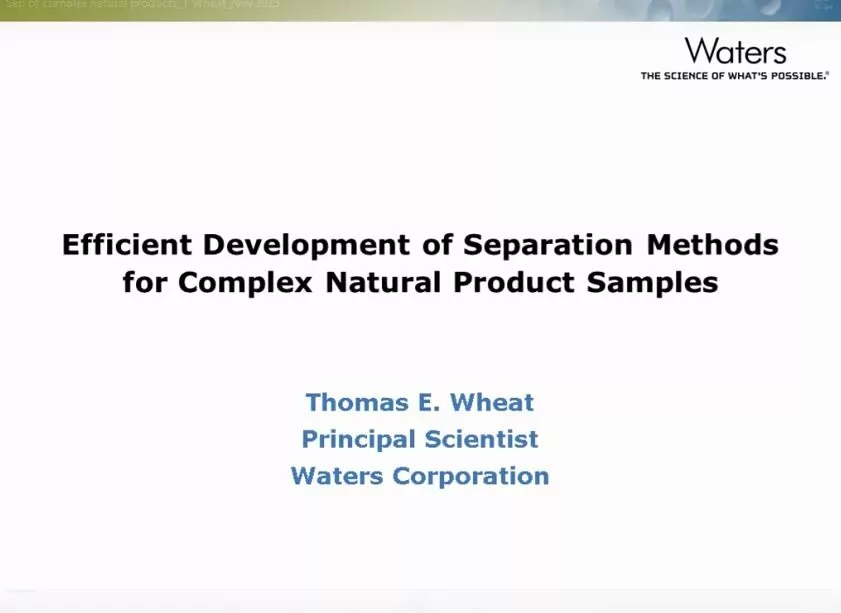Developing Separation Methods for Natural Products: Questions and Answers from a Webinar with Dr. Tom Wheat

The development of chromatographic methods for natural products is challenging due to the complexity of the sample matrix and analyte chemistry. However, by understanding the fundamental parameters of your chromatography and strategies for efficient detection, there are many ways to overcome these difficulties.
I recently presented a webinar describing some techniques and tools used for developing separation methods for natural products. The session prompted many great questions and considerable discussion. I’m sharing the answers to these questions knowing that others will also benefit.

- Are standards required for judging peak purity, and for peak tracking?
No, standards for the peak purity and peak tracking are not required. If you did have standards, you would, of course, use them. More often, however, we use a cataloging procedure. In each chromatographic experiment, we record the mass spectrum and the UV spectrum for each peak. We then look for matching spectra in the other chromatographic experiments. Often, we observe a peak with a spectrum that we had not observed in a previous run. So, we revisit that prior experiment to look for that compound explicitly. We are iteratively building a catalog or library of the sample components. We can then match those spectral characteristics as we change the characteristics of the separation media. This can lead to a retention map for each analyte that can be used to control the development of the separation.
- Do you ever incorporate other detectors in a separation development system?
When we’re doing separations, or any kind of analytical work with a completely unknown natural product sample, we always have to question whether we’ve missed something. We routinely incorporate orthogonal detectors within our separation system. It is essential that we select each of the multiple detectors as representing a different physical or chemical principle. The combination of a UV detector with a mass detector meets that criterion. It is very common to add a third detector, most often an evaporative light scattering detector, to the system. The column eluate is divided among these three detectors, so that we can also detect compounds that have no UV absorbance and no ionization.
- Can the methods that you devise according to these principles be used for isolating the compounds of interest?
Yes. We would, however, choose to use only volatile mobile phase components to develop the separation. That makes it easier to recover the collected material by simply evaporating or lyophilizing the fraction. We would choose those mobile phases anyway if we were incorporating mass spectrometry or evaporative light scattering detection. We would usually try to get more complete resolution if the method is to be used for isolation so that we can increase the sample load without compromising purity. That would also let us scale the method to larger particle sizes for improved economy with larger samples.
- For screening unknowns, would it be useful to use 50% methanol, 50% acetonitrile (with formic acid) as mobile phase B?
Using mixtures of organic solvents is a well-established practice with a successful history. It can, however, be hard to do the development experiments in a systematic and controlled way. I have used a protocol with a series of experiments. The sample is analyzed first, for example, in 100% acetonitrile. Then a series of runs is executed with 67% acetonitrile/33% methanol, 67% methanol/33% acetonitrile and 100% methanol. From those four experiments, the effect of the changing proportions of the mixture of solvents on the selectivity of the separation can be recognized. You can choose an intermediate point for the best separation in a systematic way. For these experiments, it is most convenient to use a multi-solvent delivery system. The four solvents can be blended in on-demand so there is no need to manually prepare all the different mobile phases.
These points of discussion cover the wide span of analytical principles applied to the separation methods for natural products. Successful development of this group of assays requires attention to the control of chromatography and to the modes of detection, as well as the interpretation of the results. While natural products represent a particularly challenging class of samples, the ideas discussed here can be applied across a wide range of sample types.
If you would like to learn more and view my webinar in its entirety, click here. For information on Waters Natural Products Solutions visit us at our website.
Popular Topics
ACQUITY QDa (17) bioanalysis (11) biologics (14) biopharma (26) biopharmaceutical (36) biotherapeutics (17) case study (17) chromatography (14) data integrity (22) food analysis (12) HPLC (15) LC-MS (22) liquid chromatography (LC) (20) mass detection (16) mass spectrometry (MS) (54) method development (13) STEM (12) sustainability (12)


